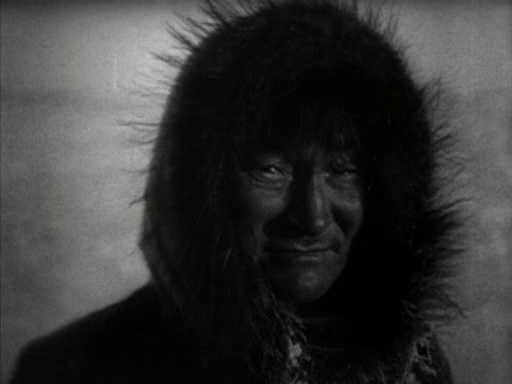A Century of Film is an ongoing series, watching a film from each year between 1917 and today. The film from 1922 is Nanook of the North.
I once watched an episode of a television show called Mountain Men. Purporting to be a real chronicle of the dangers of living on a remote mountain, this particular episode had a sequence where one of the subjects had to move a snowmobile over a frozen lake. The narrator, in a very serious tone, reminded the audience that one wrong move could lead to this man’s death. Which might be true, if there was not a camera crew watching him the entire time, going ahead of him on the lake and effectively clearing the path for him. It’s also likely there were personnel on scene to ensure the safety of said crew, who would also be paid to ensure the safety of the man in question. As part of a work of fiction, the scene would have been fairly intense, but simply by presenting the situation as real it broke the illusion. As an audience, we are aware of how cameras work, aware of laws surrounding filming, aware of how editing works and so on, and because of that we are aware that there is nothing at risk.
I remember that moment because of Nanook of the North, arguably the first documentary, has the same problem, it was impossible to get a fly on the wall perspective and also make a film. Part of that is the inherent problem with cameras, especially early cameras, they need space, light and to be present for any scene you might name. That leads to another problem, in that people’s behavior changes if they know that they are being recorded, they do things differently if a camera is in the room. Robert J. Flaherty famously staged scenes, Nanook was an actor named Allakariallak, while his people had long embraced guns for hunting they went back to spears for the sake of the film. Then again, Flaherty’s first attempt at a documentary about the north went up in smoke - literally, as the nitrate film was destroyed by an errant cigarette - and might have actually been closer to that ideal. Thanks to the inflammable early film stock, we will never know.
But what we do know, and can tell from just watching Nanook, is that the film is less real than Flaherty says it is. We can also understand why this is the case, because Flaherty knows that just filming a bunch of scenes isn't the same as making a film. Nanook, the character, exists because the film needs a narrative hook in order to give the scenes context. Making the film about a man and his family surviving gives you a story, which gives context to scenes. They're not just building an igloo, it's part of a larger hunting trip. They're not just hunting, they're providing meals for a hungry family that hasn't eaten in a long time. It gives the audience a reason to care.
Flaherty's crime in this case is being a salesman. Much of the film, staged or not, is an attempt at documenting a dying way of life. The film does depict traditions, it depicts skills needed to survive in the arctic, and in that way it’s real. The story behind building the igloo might be made up, but they’re still building an igloo, from the ground up, and showing the audience how they do it. This part is not fake, even if it’s not spontaneous. It was still filmed in the north, in freezing cold. Animals still die during hunting - fair warning, the hunting scenes might be staged but they're definitely not simulated. But the story is a way to get people to watch, and saying it's a true story is a way to sell tickets. But saying it's a true story also undermines the traditions it's trying to depict, since you don't know if the traditions are real since you know that Flaherty did lie. It would be more believable as fiction than it is as a true story, same deal with the modern man on the mountain. You don’t have to get over anyone lying if they’re open about in the first place.
Allakariallak himself is a bit of a ham, he plays the scene where Nanook is shown a gramophone for the first time as broadly as possible - he literally chews the scenery, in this case a record - and he’s having fun just being on camera. The most memorable shot is when he cuts a window out of the igloo and sticks his head out, if only for the actor’s sheer delight at the comic potential of the reveal. Whoever wrote the script, it’s clear that the people on screen find the idea of being filmed fundamentally hilarious, whether it’s the kid proudly showing off his sled or the folks who take time to slide down the hill. While they frequently get serious, especially when filming the hunt, when people have fun you get a better impression of who these people on the screen actually are.
Flaherty invented the documentary, but really, he invented reality TV, long before TV itself was invented. You have a colorful character that would be fascinating to a lot of people, you’ve got a flimsy plot to justify their actions, you film them doing their job and performing their skills, and you have people in the background complaining that the entire thing is fake.




